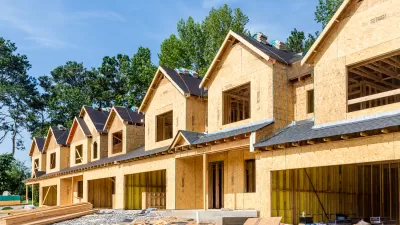Although the holidays cause millions more drivers to hit the road, delays in traffic may also stem from the congestion of goods movements by truck, both locally and across the country.
As Joseph Kane and Adie Tomer write for the Brookings Institution, "the 100 largest metro areas transport $16.2 trillion in products annually—or nearly 80 percent of all the country’s freight. Even more critically, though, over two-thirds of these goods are carried by trucks, which often traverse multiple states on their long-distance journeys. With anything from metals and machinery to electronics and textiles riding our interstates all day and night, regional markets depend on an efficient freight network to forge economic connections with one another, yet their local congestion can restrict this movement."
Looking at the major metro areas with some of the worst congestion, such as New York City, Los Angeles, Chicago, and elsewhere, traffic chokeholds "not only slow down flows in their own regions, but also dampen economic exchanges across all corners of the country, including those across multiple types of modes such as rail. As a result, congestion in one market can hurt regions hundreds or even thousands of miles away." Kane and Tomer posit that instead of "spreading investments evenly across the country or limiting attention to individual projects, it’s time to tailor our freight improvements in light of location-specific concerns."
FULL STORY: Relieving Congestion to Boost Metro Trade

Pennsylvania Mall Conversion Bill Passes House
If passed, the bill would promote the adaptive reuse of defunct commercial buildings.

Planning for Accessibility: Proximity is More Important than Mobility
Accessibility-based planning minimizes the distance that people must travel to reach desired services and activities. Measured this way, increased density can provide more total benefits than increased speeds.

Fair Housing Cannot Take a Back Seat to ‘Build, Baby, Build’
If we overlook fair housing principles in the plan to build US housing back better, we risk ending up right back where we started.

LA Metro Board Approves New 710 Freeway Plan
The newest plan for the 710 corridor claims it will not displace any residents.

Austin’s Proposed EV Charging Rules Regulate Station Locations, Size
City planners say the new rules would ensure an efficient distribution of charging infrastructure across the city and prevent an overconcentration in residential areas.

Making California State Parks More Climate-Resilient
A recently released report offers recommendations for keeping state parks healthy and robust, including acquiring additional land for conservation and recreation.
City of Costa Mesa
Licking County
Barrett Planning Group LLC
HUD's Office of Policy Development and Research
Mpact Transit + Community
HUD's Office of Policy Development and Research
Tufts University, Department of Urban and Environmental Policy & Planning
City of Universal City TX
ULI Northwest Arkansas
Urban Design for Planners 1: Software Tools
This six-course series explores essential urban design concepts using open source software and equips planners with the tools they need to participate fully in the urban design process.
Planning for Universal Design
Learn the tools for implementing Universal Design in planning regulations.


























